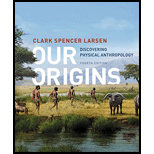
Introduction: Primates, the group containing all species commonly related to lemurs, monkeys, and apes, are members of the biological order, and the latter category includes human beings.
Answer to Problem 1SQ
Correct answer: a. body and canine size.
Explanation of Solution
Reason for the correct answer:
As male primates compete for females, whether they compete individually or in groups, the bodies of men adapt. Sexual dimorphism in body size and canine size is considerably higher in such societies than in societies where males do not compete. This difference shows that men must be higher and intense to compete effectively for females.
Option a. is given as “body and canine size”.
Hence, the correct answer is option a.
Reasons for incorrect answers:
Option b. is given as “mode of locomotion”.
Primates use bipedalism, arboreal and terrestrial mode for locomotion. However, the mode of locomotion of male and female primates have not differed much from each other. Therefore, option b is incorrect.
Option c. is given as “tool use”.
Primates showed learned behaviors and cultural traditions, such as social care, use of tools and speech, which are unique to specific groups and regions. They showed their culture in a certain manner. Therefore, option c is incorrect.
Option d. is given as “color”.
There is no color difference among the male and female primates. Therefore, option d is incorrect.
Hence, options b., c., and d. are incorrect.
Thus, the body and canine sizes of both male and female primates have differed primarily.
Want to see more full solutions like this?
Chapter 7 Solutions
Our Origins: Discovering Physical Anthropology (Fourth Edition)
- Which of the following is NOT an ancestral trait in primates? A. Trichromacy B. Having Nocturnal Adaptations C. Fur D. Clawsarrow_forwardMammals are distinguished from other animals based ona. size and hair type.b. mode of reproduction.c. number of limbs and method of caring for young.d. number of mammary glands and number of offspring.arrow_forwardWhich of the following derived traits is unique to New World Monkeys, who live in the trees? Group of answer choices A: a grooming claw. B: a prehensile tail C: female genital swelling D: a sacculated stomacharrow_forward
- Primates can be distinguished from other mammals by their Question 34 options: a) hair and mammary glands. b) lack of a tail. c) adaptations for climbing trees, such as hands and feet that grip and arms/shoulders for brachiation. d) amniotic eggs and presence of a jaw.arrow_forwardDescribe three adaptations that allow for flight in birds.arrow_forwardNew World monkeys_____ . a. lack a tail c. are dry-nosed primates b. are bipedal d. include human ancestorsarrow_forward
- In “Our Origins” book by Larsen, what has recent research revealed about chimpanzees? A.) some populations use stone tools and cut animal hides B.) they can control their vocalizations with the same brain centers as humans C.) savanna populations sharpen their sticks and hunt galagosarrow_forwardAlthough many mammals have binocular vision, the anatomical adaptation(s) that set primates apart from these mammals is (are)a. prehensile tails.b. opposable digits on hands.c. mammary glands.d. hair-covered skin.arrow_forwardExplain what distinguishes hominoids from other primates. Choose two hominoids and explain how their commonalites, differences, and similarities to humans. View keyboard shortcutsarrow_forward
- Which of the following is NOT a derived trait in primates? A. Claws B. Opposable fingers/toes C. Postorbital bar/plate D. Trichromacyarrow_forwardWhy are plesiadapiforms most likely the earliest primate ancestors? A. They do not have a postorbital bar or plate B. Their eyes are forward-facing C. They have grasping fingers D. They have clawsarrow_forwardBoth the calcaneus and the first toe of bipeds are relatively ____ in comparison to the rest of the foot when compared to the feet in in other primates/ a. more gracile b. more diminutive c. short d. largearrow_forward
 Concepts of BiologyBiologyISBN:9781938168116Author:Samantha Fowler, Rebecca Roush, James WisePublisher:OpenStax College
Concepts of BiologyBiologyISBN:9781938168116Author:Samantha Fowler, Rebecca Roush, James WisePublisher:OpenStax College
